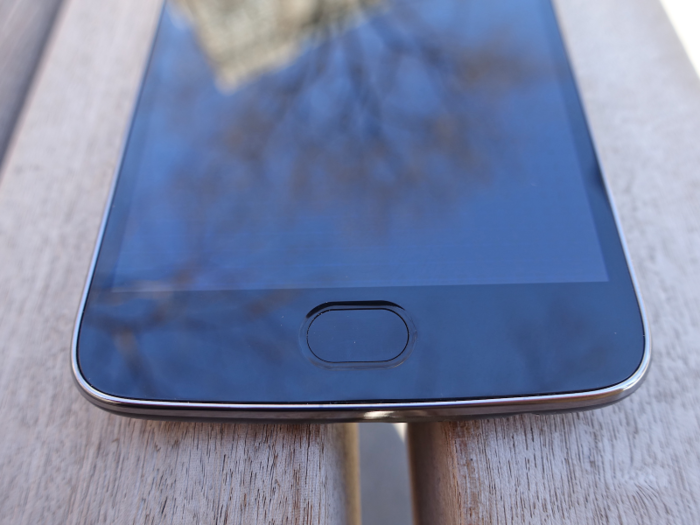The newest Moto G is the best phone you can buy for under $300
The Moto G5 Plus' design is best described as "a phone." It's a black and silver slab with rounded corners and a familiar mix of brushed aluminum and smooth glass. It's boring, but it's fine. It's also a big step up from the plastic of its predecessors.

That said, Lenovo has cut some corners to keep the price down. There's no NFC in the US model, meaning you can't make tap-and-go mobile payments, and you're saddled with a micro-USB port instead of the faster and increasingly popular USB-C. And while Lenovo says the phone can survive light rain and splashes, it doesn't have an official water-resistance rating, so you can't be too careless.

These are not dealbreakers, but they are seemingly preventable annoyances. Such is life with an inexpensive phone. I'll take the comfort of a sturdy, aluminum frame every day if these had to be the trade-offs. I doubt that's the case, though.
Quality displays are just about table stakes for smartphones today, and the Moto G5 Plus' screen follows suit. It's a 5.2-inch IPS panel with a sharp-enough 1080p resolution. It could be brighter, and its colors do not "pop" the way they would on an OLED screen like that of the Samsung Galaxy S7, but it'll be pleasant enough for most. It doesn't wash out at an angle, either.

Underneath that display is a fingerprint sensor. I'm not the biggest fan of this placement — resting your finger on the back of a phone feels more natural than reaching to the bottom — but for what it is, it's fast.

More significantly, it can also be used in place of the back, home, and recent apps buttons that Android usually plants onscreen. If you turn on Lenovo's "one button nav" feature, tapping the fingerprint sensor serves as the home button, swiping left becomes back, and swiping right brings up your open apps.
I love this: It's surprisingly easy to get used to, for one, and it lets you use the entirety of the display for actually looking at things. If the sensor had to be below the display, features like this are a good way to justify it.
Like past Moto phones, the Moto G5 Plus runs a near-untouched version of Android. This is a good thing: It makes the software fast, attractive, and free of redundancies. Lenovo adds a handful of familiar extras, but they are not forced upon you, and nearly all of them are genuinely useful. It's almost like having a Nexus device.

Almost. The great promise of Nexus (and now Pixel) devices is that they are updated with Android's newest features as soon as possible. When Motorola was owned by Google, the big Moto phones were brought up to date with similar speed. Now that it's owned by Lenovo, it's just another company, even though its software still has few customizations to get in the way.
For now, it's hard to say if the Moto G will be updated any quicker. For what it's worth, it's starting with Android 7.0, which is good, but technically not the latest version of the OS. Meanwhile, the latest security patch on my review unit is from January; that, too, is behind.
Nevertheless, the fact that Moto's software is clean gives it one leg-up over its peers, and Lenovo's add-ons are nifty. The "Moto Display" mode that flashes your notifications without turning on the display is still here, as are the myriad gesture controls. Being able to launch the camera just by twisting the phone twice is never not great.
Also, there's an FM radio app. Did you know that most phones in America have the ability to play FM radio over the air, but that most phone manufacturers purposefully disable it, sometimes in an effort to get you to pay for streaming apps? Now you do! This is an anti-consumer practice, so more phones should follow Lenovo's lead here.
The Moto G5 Plus is no blazer, and doesn't impress on most benchmark tests. But for most purposes, it's perfectly acceptable. The light software helps, but the mid-range Snapdragon 625 chip at its core is able to load up apps and browse the web without major annoyances. Moving through Android is snappy enough, and the whole thing doesn't get overly hot.

It's enough to run multiple apps onscreen at once, too. Just don’t expect a powerhouse: You can play higher-end games like "Lara Croft Go" just fine, but it's never as smooth as it'd be with a stronger chip and GPU. You'll still see the occasional stammer when things get heavy.
And again, this is all with 4 GB of memory backing it up. I'd be a little more hesitant to cut the RAM in half, but since I wasn't able to test the $229 model, I can't say if it'll be worth it.
Either way, storage space shouldn't be a problem. You get a more-than-serviceable 64GB on the higher-end model, and you can add another 128 GB through a microSD card. That's great. Call quality is fine as well.
Where the Moto G5 Plus impresses the most is battery life. The Snapdragon 625 isn't notably fast, but it is efficient. Combined with a 3,000mAh battery and the not-huge, not-overly-sharp display, it allows the device to last far more than a day with ordinary use. If you're conservative, it's not out of the question to get two work days out of it. This is the single best reason to buy the phone.

Though, as noted above, you have to recharge with microUSB, not the newer USB-C. Motorola does have a "fast" charger in the box, though, which gets at least a few hours of juice back into the device in a 15 minutes or so. But this could be better.
Lenovo is talking up the 12-megapixel camera here as far superior than its peers, but that wasn't entirely justified in my testing.
That doesn't mean it's bad: It captures quick, the app is easy to use, and in good lighting, it has less noise and more accurate detail than a similarly-priced competitor like Huawei's Honor 6X. It can also capture video in 4K resolution, if you've got a screen that can make use of that.
But nothing ever really pops, and, as there's no optical image stabilization, I had instances where it'd fail to focus on what's in front of me without multiple tries, even as I held my hands steady.
And, per usual, all of this kind of goes to hell in the dark. Despite its relatively wide-aperture lens — which is meant to let in more light — the Moto G5 Plus is still prone to mushiness and distorted colors at night.
I can't complain too much: This is still a sub-$300 phone, and in that context it's more than decent. But it's a clear step down from good $400 phones like the ZTE Axon 7 or OnePlus 3T, let alone a top-end Galaxy, Pixel, or iPhone.
Here's another sample photo:

And one more:

Still, apart from a few missing extras, the Moto G5 Plus doesn't really get much wrong. Its battery is superb, its clean take on Android is still great, and the essentials are totally pleasant for the money. If you only have $300 to spend on a new phone, it should be your starting point. Stop me if you've heard something like that before.

All that said, if you can spare $100 more, there is a marked jump up between this and the aforementioned OnePlus and ZTE phones. But if that's a bridge too far, the G5 Plus is a steady compromise.
Popular Right Now
Popular Keywords
- India’s wearables market decline
- Vivo V40 Pro vs OnePlus 12R
- Nothing Phone (2a) Plus vs OnePlus Nord 4
- Upcoming smartphones launching in August
- Nothing Phone (2a) review
- Current Location in Google
- Hide Whatsapp Messages
- Phone is hacked or not
- Whatsapp Deleted Messages
- Download photos from Whatsapp
- Instagram Messages
- How to lock facebook profile
- Android 14
- Unfollowed on Instagram
Advertisement